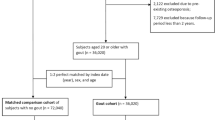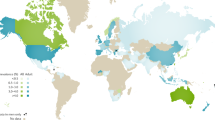Abstract
Previous studies have reported that thyroid dysfunction is associated with increased serum uric acid levels; however, the relationship between hyperthyroidism and incidence of clinical manifestations of gout has not been fully investigated. Therefore, this study aimed to longitudinally investigate the risk of gout in patients with hyperthyroidism. This nationwide retrospective cohort study used data from the Korean National Health Claims Database. We included 76,494 patients with hyperthyroidism and 76,542 age- and sex-matched controls. A Cox proportional hazard regression model was used to adjust for potential confounders and estimate the risk of incident gout in patients with hyperthyroidism. During a mean follow-up of 9 years, incident gout developed in 3,655 (4.8%) patients with hyperthyroidism and 3251 (4.2%) controls. Hyperthyroidism was significantly associated with increased risk of incident gout [adjusted hazard ratio (HR), 1.12; 95% confidence interval (CI) 1.07–1.18], independent of baseline metabolic profiles. The median time from the diagnosis of hyperthyroidism to the development of gout was 6 years. When stratified by age and sex, the risk of gout was still significant in the < 50-year age group (HR: 1.2, 95% CI 1.12–1.29) and males (HR: 1.21, 95% CI 1.12–1.30), but not in the older age group (> 50 years) and females. Hyperthyroidism is an important risk factor for incident gout, particularly in younger age groups (< 50 years) and males. Our results highlight the importance of continuous screening for gout in patients with hyperthyroidism.


Similar content being viewed by others
Data availability
The authors are restricted from sharing the data in this study, because the Korean National Health Insurance Service (NHIS) owns the data. Researchers can request access on the NHIS at https://nhiss.nhis.or.kr. Details of this process are available at http://nhiss.nhis.or.kr/bd/ab/bdaba000eng.do.
References
Dehlin M, Jacobsson L, Roddy E (2020) Global epidemiology of gout: prevalence, incidence, treatment patterns and risk factors. Nat Rev Rheumatol 16(7):380–390. https://doi.org/10.1038/s41584-020-0441-1
Kim JW, Kwak SG, Lee H, Kim SK, Choe JY, Park SH (2017) Prevalence and incidence of gout in Korea: data from the national health claims database 2007–2015. Rheumatol Int 37(9):1499–1506. https://doi.org/10.1007/s00296-017-3768-4
Park YB, Park YS, Lee SC, Yoon SJ, Lee SK (2003) Clinical analysis of gouty patients with normouricaemia at diagnosis. Ann Rheum Dis 62(1):90–92. https://doi.org/10.1136/ard.62.1.90
Schlesinger N, Norquist JM, Watson DJ (2009) Serum urate during acute gout. J Rheumatol 36(6):1287–1289. https://doi.org/10.3899/jrheum.080938
McCormick N, O’Connor MJ, Yokose C, Merriman TR, Mount DB, Leong A, Choi HK (2021) Assessing the causal relationships between insulin resistance and hyperuricemia and gout using bidirectional mendelian randomization. Arthritis Rheumatol 73(11):2096–2104. https://doi.org/10.1002/art.41779
Lee SW, Lee SS, Oh DH, Park DJ, Kim HS, Choi JR, Chae SC, Yun KJ, Chung WT, Choe JY, Kim SK (2016) Genetic association for P2X7R rs3751142 and CARD8 rs2043211 7. 7. Polymorphisms for susceptibility of gout in korean men: multi-center study. J Korean Med Sci 31(10):1566–1570. https://doi.org/10.3346/jkms.2016.31.10.1566
Rho YH, Choi SJ, Lee YH, Ji JD, Choi KM, Baik SH, Chung SH, Kim CG, Choe JY, Lee SW, Chung WT, Song GG (2005) The prevalence of metabolic syndrome in patients with gout: a multicenter study. J Korean Med Sci 20(6):1029–1033. https://doi.org/10.3346/jkms.2005.20.6.1029
Choi HJ, Moon KW, Kim HO, Lee YA, Hong SJ, Jung JY, Kim HA, Suh CH, Ha YJ, Kim IJ, Lee J, Park EK, Lee SG, Seo MR, Baek HJ, Choi ST, Song JS (2020) Seasonal variations and associated factors of gout attacks: a prospective multicenter study in Korea. J Korean Med Sci 35(20):e133. https://doi.org/10.3346/jkms.2020.35.e133
See LC, Kuo CF, Yu KH, Luo SF, Chou IJ, Ko YS, Chiou MJ, Liu JR (2014) Hyperthyroid and hypothyroid status was strongly associated with gout and weakly associated with hyperuricaemia. PLoS One 9(12):e114579. https://doi.org/10.1371/journal.pone.0114579
Giordano N, Santacroce C, Mattii G, Geraci S, Amendola A, Gennari C (2001) Hyperuricemia and gout in thyroid endocrine disorders. Clin Exp Rheumatol 19(6):661–665
Zhang J, Meng Z, Zhang Q, Liu L, Song K, Tan J, Li X, Jia Q, Zhang G, He Y (2016) Gender impact on the correlations between subclinical thyroid dysfunction and hyperuricemia in Chinese. Clin Rheumatol 35(1):143–149. https://doi.org/10.1007/s10067-015-2867-4
Kuo CF, Grainge MJ, Mallen C, Zhang W, Doherty M (2016) Comorbidities in patients with gout prior to and following diagnosis: case-control study. Ann Rheum Dis 75(1):210–217. https://doi.org/10.1136/annrheumdis-2014-206410
Erickson AR, Enzenauer RJ, Nordstrom DM, Merenich JA (1994) The prevalence of hypothyroidism in gout. Am J Med 97(3):231–234. https://doi.org/10.1016/0002-9343(94)90005-1
Mariani LH, Berns JS (2012) The renal manifestations of thyroid disease. J Am Soc Nephrol 23(1):22–26. https://doi.org/10.1681/asn.2010070766
Bruderer SG, Meier CR, Jick SS, Bodmer M (2017) The association between thyroid disorders and incident gout: population-based case-control study. Clin Epidemiol 9:205–215. https://doi.org/10.2147/clep.S128627
Liu X, Zhang J, Meng Z, Jia Q, Tan J, Zhang G, Li X, Liu N, Hu T, Zhou P, Zhang Q, Song K, Jia Q (2019) Gender impact on the correlations between Graves’ hyperthyroidism and hyperuricemia in Chinese. Ir J Med Sci 188(3):843–848. https://doi.org/10.1007/s11845-018-1939-2
Sato A, Shirota T, Shinoda T, Komiya I, Aizawa T, Takemura Y, Yamada T (1995) Hyperuricemia in patients with hyperthyroidism due to Graves’ disease. Metabolism 44(2):207–211. https://doi.org/10.1016/0026-0495(95)90266-x
Lee J, Lee JS, Park SH, Shin SA, Kim K (2017) Cohort profile: the national health insurance service-national sample cohort (NHIS-NSC), South Korea. Int J Epidemiol 46(2):e15. https://doi.org/10.1093/ije/dyv319
Chung JH (2021) Antithyroid drug treatment in graves’ disease. Endocrinol Metab (Seoul) 36(3):491–499. https://doi.org/10.3803/EnM.2021.1070
Moon JH, Yi KH (2013) The diagnosis and management of hyperthyroidism in Korea: consensus report of the korean thyroid association. Endocrinol Metab (Seoul) 28(4):275–279. https://doi.org/10.3803/EnM.2013.28.4.275
Kwon H, Jung JH, Han KD, Park YG, Cho JH, Lee DY, Han JM, Park SE, Rhee EJ, Lee WY (2018) Prevalence and annual incidence of thyroid disease in Korea from 2006 to 2015: a nationwide population-based cohort study. Endocrinol Metab (Seoul) 33(2):260–267. https://doi.org/10.3803/EnM.2018.33.2.260
Perez-Ruiz F, Chinchilla SP, Atxotegi J, Urionagüena I, Herrero-Beites AM, Aniel-Quiroga MA (2015) Increase in thyroid stimulating hormone levels in patients with gout treated with inhibitors of xanthine oxidoreductase. Rheumatol Int 35(11):1857–1861. https://doi.org/10.1007/s00296-015-3355-5
den Hollander JG, Wulkan RW, Mantel MJ, Berghout A (2005) Correlation between severity of thyroid dysfunction and renal function. Clin Endocrinol (Oxf) 62(4):423–427. https://doi.org/10.1111/j.1365-2265.2005.02236.x
Fukui H, Taniguchi S, Ueta Y, Yoshida A, Ohtahara A, Hisatome I, Shigemasa C (2001) Enhanced activity of the purine nucleotide cycle of the exercising muscle in patients with hyperthyroidism. J Clin Endocrinol Metab 86(5):2205–2210. https://doi.org/10.1210/jcem.86.5.7516
Shirota T, Shinoda T, Yamada T, Aizawa T (1992) Alteration of renal function in hyperthyroidism: increased tubular secretion of creatinine and decreased distal tubule delivery of chloride. Metabolism 41(4):402–405. https://doi.org/10.1016/0026-0495(92)90075-l
Chao G, Zhu Y, Fang L (2019) Retrospective analysis of the correlation between uric acid and thyroid hormone in people with normal thyroid function. J Diabetes Res 2019:5904264. https://doi.org/10.1155/2019/5904264
Eun Y, Kim IY, Han K, Lee KN, Lee DY, Shin DW, Kang S, Lee S, Cha HS, Koh EM, Lee J, Kim H (2021) Association between female reproductive factors and gout: a nationwide population-based cohort study of 1 million postmenopausal women. Arthritis Res Ther 23(1):304. https://doi.org/10.1186/s13075-021-02701-w
Hak AE, Curhan GC, Grodstein F, Choi HK (2010) Menopause, postmenopausal hormone use and risk of incident gout. Ann Rheum Dis 69(7):1305–1309. https://doi.org/10.1136/ard.2009.109884
Meuwese CL, Gussekloo J, de Craen AJ, Dekker FW, den Elzen WP (2014) Thyroid status and renal function in older persons in the general population. J Clin Endocrinol Metab 99(8):2689–2696. https://doi.org/10.1210/jc.2013-3778
Choi HK, McCormick N, Yokose C (2022) Excess comorbidities in gout: the causal paradigm and pleiotropic approaches to care. Nat Rev Rheumatol 18(2):97–111. https://doi.org/10.1038/s41584-021-00725-9
Joo K, Kwon SR, Lim MJ, Jung KH, Joo H, Park W (2014) Prevention of comorbidity and acute attack of gout by uric acid lowering therapy. J Korean Med Sci 29(5):657–661. https://doi.org/10.3346/jkms.2014.29.5.657
Poudel DR, Karmacharya P, Donato A (2016) Risk of acute gout among active smokers: data from nationwide inpatient sample. Clin Rheumatol 35(12):3015–3018. https://doi.org/10.1007/s10067-016-3415-6
Kim Y, Kang J, Kim GT (2018) Prevalence of hyperuricemia and its associated factors in the general Korean population: an analysis of a population-based nationally representative sample. Clin Rheumatol 37(9):2529–2538. https://doi.org/10.1007/s10067-018-4130-2
Acknowledgements
We would like to thank Editage (www.editage.co.kr) for English language editing. No Artificial Intelligence software was used to draft or edit the manuscript.
Funding
This work was supported by a faculty grant from Myongji Hospital (grant number 2201-03-04).
Author information
Authors and Affiliations
Contributions
All authors meet the ICMJE criteria for authorship and contributed to the study conception and design of this work. Data collection and interpretation were performed by JYL and SYS, and the statistical analysis was performed by JYL. The first draft of the manuscript was written by JYL and revised by SYP and SYS. All the authors read and approved the final manuscript. All authors take full responsibility for the integrity and accuracy of all aspects of the work.
Corresponding author
Ethics declarations
Conflict of interest
Ju-Yeun Lee, So-Yeon Park and Seo Young Sohn declare that the authors have no conflict of interest.
Ethical approval
This study was performed in accordance with the Declaration of Helsinki and was approved by the institutional review board of Myongji hospital, Hanyang University College of Medicine on November 12, 2021. The study protocol number is IRB No. 2021-11-020.
Additional information
Publisher's Note
Springer Nature remains neutral with regard to jurisdictional claims in published maps and institutional affiliations.
Supplementary Information
Below is the link to the electronic supplementary material.
Rights and permissions
Springer Nature or its licensor (e.g. a society or other partner) holds exclusive rights to this article under a publishing agreement with the author(s) or other rightsholder(s); author self-archiving of the accepted manuscript version of this article is solely governed by the terms of such publishing agreement and applicable law.
About this article
Cite this article
Lee, JY., Park, SY. & Sohn, S.Y. Increased risk of incident gout in patients with hyperthyroidism: a nationwide retrospective cohort study. Rheumatol Int 44, 451–458 (2024). https://doi.org/10.1007/s00296-023-05423-1
Received:
Accepted:
Published:
Issue Date:
DOI: https://doi.org/10.1007/s00296-023-05423-1




